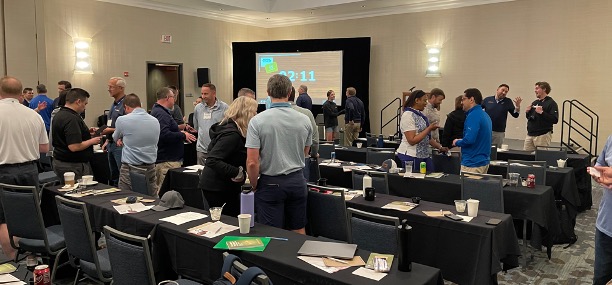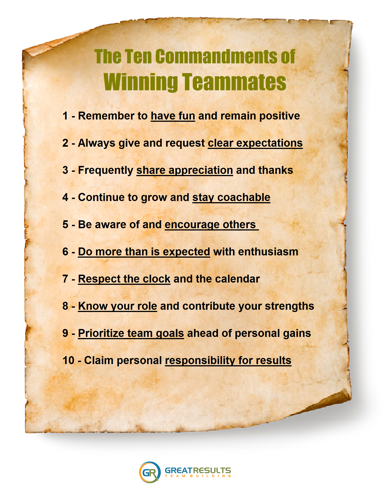A winning team is not built by talent alone.
It is built by the behaviors and attitudes of its teammates.
And those teammates are who you will look to as possible future leaders…
Effective succession planning is a cornerstone of sustainable leadership, and identifying top talent within your team is key to developing future leaders. For managers focused on building a pipeline of leadership-ready individuals, it’s critical to understand how teammates progress through different levels of performance and influence.
By categorizing team members based on their behaviors and contributions, you can better determine which individuals have the potential to step into leadership roles. This framework, inspired by Jim Collins’ concept of Level 5 Leadership, provides a clear path for evaluating and nurturing future leaders within your organization.
A team with engaged, influential, and culture-driven members is far more productive and resilient. This difference in morale and performance is not just about individual effort but about how individuals interact with and elevate one another.
The progression from just “doing their job” to inspiring others to do theirs better is what defines a winning teammate… and becomes a noticeable trait of potential future leaders in your organization.
The following framework will show you how to identify the value and effectiveness of people within any team environment.
The Four Levels of Teammates and Succession Planning
Drawing on Jim Collins’ concept of Level 5 Leadership, which describes how great leaders evolve beyond individual ambition to lead teams to collective greatness, we can apply a similar approach to identifying a great teammate.
A team member’s value progresses through four distinct levels—each offering a deeper influence on the team’s success and high potential for a future leadership role.
Identifying great teammates is essential for leaders who are focused on effective succession planning, as it allows them to cultivate a pipeline of talent ready to step into leadership roles. By recognizing the skills, behaviors, and potential in current team members, leaders can ensure that their organization is not only prepared for future changes but also equipped with individuals who embody the company’s values and culture.
This foresight minimizes the disruption that often accompanies leadership transitions and enables a smoother, more seamless transfer of responsibilities.
Great teammates often demonstrate qualities like initiative, accountability, and collaboration—traits that are also vital in leadership roles.
Here’s how you can identify which level your people are at, and what behaviors will help them to grow to the next stage of being truly impactful teammates.

Level 1: The Reliable Contributor
At the most fundamental level, a Reliable Contributor is the foundation of any effective team. This team member is dependable and consistent, showing up to do their job well. They take responsibility for their own tasks and work efficiently within their own space, rarely requiring oversight. However, while they are productive and trustworthy, their focus remains primarily on individual performance.
Reliable Contributors are valuable because they can be counted on to complete tasks on time and to a high standard. Yet, their impact is limited to their own assignments. They typically avoid stretching beyond their comfort zone or engaging with team members outside of direct needs.
Contributor Behaviors:
- Completing tasks on time with minimal supervision.
- Maintaining strong work habits, such as punctuality and attention to detail.
- Offering help occasionally but operating mainly in a self-contained manner.
While being a Reliable Contributor is a solid foundation, to truly maximize their influence on the team, they need to step outside of just their own workload and begin engaging with others more proactively.
Level 2: The Engaged Collaborator
The Engaged Collaborator moves beyond individual focus and starts to think in terms of team success. At this level, teammates begin to communicate more openly, offer ideas during discussions, and seek to support their colleagues. The shift here is from thinking “What can I do to succeed?” to “What can we do to succeed?” This mindset change increases both individual and group effectiveness.
Engaged Collaborators are often found initiating team efforts, asking questions in meetings, and being eager to volunteer for collaborative projects. They understand that teamwork is a collective endeavor and that their input in discussions can elevate the group. Their interpersonal skills become more pronounced as they show empathy, listen to others, and proactively offer assistance when needed.
Collaborator Behaviors:
- Actively participating in discussions and offering constructive ideas.
- Volunteering to help others complete their work, ensuring the group’s success.
- Demonstrating strong communication skills, listening and providing feedback.
Engaged Collaborators are critical to the team’s dynamics because they foster a culture of shared ownership and ensure that the team’s success is prioritized. This stage is often where an individual’s contributions begin to have a ripple effect on the team.
Level 3: The Team Influencer
The next step up is the Team Influencer, a teammate who starts to shape the direction of the team. While they may not have an official leadership title, their actions and words inspire others to elevate their performance. This individual is often a natural mentor, guiding less experienced team members and offering constructive feedback.
Team Influencers are skilled at identifying where the team needs improvement and are unafraid to speak up when standards are not being met. Conversely, they are quick to celebrate positive contributions and maintain a consistent level of energy that keeps the group motivated. Their influence lies not in authority, but in the trust and respect they’ve earned through their own behavior and encouragement of others.
Influencer Behaviors:
- Leading by example, especially in effort, attitude, and consistency.
- Offering constructive feedback, helping the team maintain high standards.
- Acting as a mentor to less experienced team members, ensuring their development.
Team Influencers are a key component in elevating team performance because they actively align the group towards shared goals. Their ability to inspire, correct, and guide without a formal title makes them invaluable in driving long-term team success.
Level 4: The Culture Builder
At the highest level of impact is the Culture Builder—a teammate who transcends short-term achievements and focuses on building a team culture that is sustainable, resilient, and collaborative. Culture Builders are not just concerned with today’s performance but with creating an environment where everyone can thrive in the future.
These team members take on intentional roles as mentors and often help to implement systems that encourage better communication, accountability, and collaboration. Their ability to develop trust within the team ensures that the group can navigate challenges more effectively. They are the glue that holds the team together, fostering cohesion even in tough times. By developing a team culture that encourages openness, trust, and shared responsibility, Culture Builders leave a lasting impact on the team’s success.
Culture Builder Behaviors:
- Actively mentoring others and developing team members to reach their potential.
- Implementing systems or practices that improve team communication and accountability.
- Prioritizing the team’s long-term goals and success over personal recognition.
Culture Builders are the ultimate team players. Their contributions extend beyond their own workload to shape the very essence of how the team functions and collaborates. They are instrumental in creating a team environment that is healthy, productive, and built for sustainable success, and are your best option in succession planning.

Succession Planning Starts with Identifying Top Teammates
Identifying which level each teammate occupies helps managers target development efforts to maximize individual growth and team success. Reliable Contributors can be coached into Engaged Collaborators, and Collaborators can be nurtured into Influencers.
Eventually, Team Influencers can evolve into Culture Builders—the ultimate leaders who shape not only team performance but also the organization’s culture.
By aligning succession planning efforts with the behaviors exhibited at each level, managers can develop a strong pipeline of future leaders who are prepared to take on higher responsibilities. If you want to ensure your organization is built for sustainable success, focus on identifying and developing these key behaviors across your team.
Succession planning benefits from identifying high-potential teammates because it allows leaders to align personal career aspirations with the organization’s needs.
When leaders have a clear understanding of who their top performers are, they can have intentional conversations about future goals and create a roadmap that benefits both the individual and the company. This level of preparation fosters loyalty and retention, as team members see a future for themselves within the organization.
By proactively identifying and developing future leaders from within, succession planning becomes a continuous, thoughtful process rather than a last-minute scramble. Great teammates who are nurtured and invested in are more likely to rise to the occasion, ensuring that leadership transitions strengthen the team and move the organization forward.
The difference between a good teammate and a great one lies in the progression through these levels. Each step adds a new layer of influence and value, not just to the team but to their own career and leadership journey.
If you want to develop your team’s potential and help them reach higher levels of impact, I can help! As an experienced and interactive speaker and facilitator, I’ve worked with countless teams to improve communication, collaboration, and accountability. I understand that the best team building activities seek to accomplish more than just a few laughs and shallow conversations…
Contact me today to schedule a memorable and interactive professional development session that will help your team grow together and achieve great results!
– – – – –

Sean Glaze is an engaging team building speaker and interactive facilitator who helps organizations develop more effective leaders and build more positive and profitable workplace cultures.
Sean is the author of four books, The Unexpected Leader, Rapid Teamwork, The 10 Commandments of Winning Teammates, and Staying Coachable – each one an entertaining parable with powerful take-aways for team growth and leadership!
What issues are YOU dealing with that would disappear if you could build an exceptional team culture that inspired connection, accountability, and a team-first attitude
WANT A PEEK INSIDE SEAN’S TOOLBOX OF RESOURCES FOR TEAM LEADERS?
GET ACCESS TO OVER 50 USEFUL HANDOUTS AND
ACTIVITIES FOR SMART TEAM LEADERS BY CLICKING HERE!

Use Connection Chats to Engineer Better Collaboration Across Every Division on Your Team

Effective Leaders Build Trust and Teamwork by Focusing on Leadership Development

The Power of a Sticky Culture in Boosting Organizational Performance and Retention

Are Your Team Standards Seen as Suggestions or Recognized as Requirements?
Books and Resources for Leaders
Check other blog
Use Connection Chats to Engineer Better Collaboration Across Every Division on Your Team
Effective Leaders Build Trust and Teamwork by Focusing on Leadership Development
The Power of a Sticky Culture in Boosting Organizational Performance and Retention
Contact Sean

Connect with Sean

Tell Sean About
Your Event
Tell Sean About
Your Event
"*" indicates required fields















